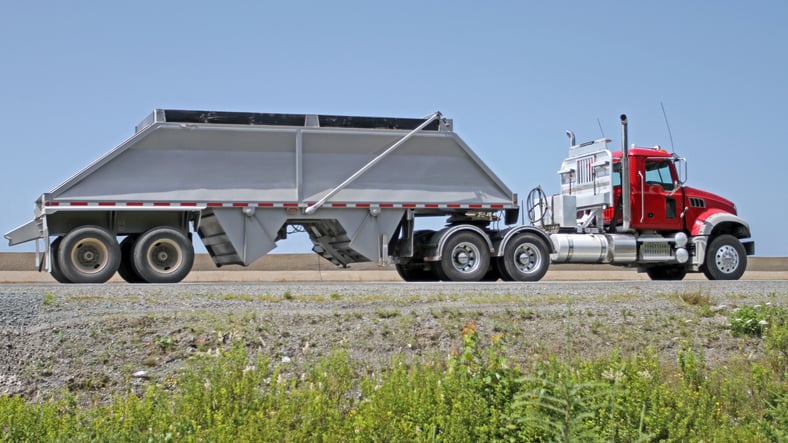choosing the right aggregate hauling equipment for your job
In the world of construction, selecting the appropriate aggregate hauling equipment is crucial for ensuring a smooth and efficient transportation...
2 min read
.png) Lauren Mire
:
6/27/23 8:00 AM
Lauren Mire
:
6/27/23 8:00 AM

When it comes to trucking, proper weight distribution is a critical factor that directly impacts safety, stability, and efficiency. Whether you're involved in hauling dry bulk, liquid bulk, aggregate, waste, or oil, understanding the key factors that influence weight distribution is crucial. This article aims to provide an informative and objective analysis of proper weight distribution for safe and balanced hauling, exploring tradeoffs, challenges, and the importance of considering the impact when making decisions.
Proper weight distribution ensures that the load is evenly distributed across the axles of the truck and trailer, maximizing stability and minimizing the risk of accidents. It prevents excessive strain on specific components, such as tires, brakes, and suspension systems, prolonging their lifespan and reducing maintenance costs. Additionally, balanced weight distribution enhances fuel efficiency, improves handling, and complies with legal weight restrictions, avoiding penalties and regulatory issues.
Different types of hauling, such as dry bulk, aggregate, liquid bulk, waste hauling, and oil hauling, require specific considerations for weight distribution. Each load type has unique characteristics that affect weight distribution, such as density, volume, and shifting properties. Understanding these factors is vital for achieving proper weight distribution.
The configuration of the trailer, including the number of axles, axle spacing, and axle ratings, significantly impacts weight distribution. Manufacturers design trailers with specific load capacities and weight distribution characteristics, ensuring optimal performance under different hauling conditions. Choosing the appropriate trailer configuration for your specific needs is essential for achieving balanced weight distribution.
Achieving proper weight distribution often involves tradeoffs between maximizing load capacity and maintaining balance. Increasing the load capacity beyond the recommended limits can lead to imbalanced weight distribution and compromise safety. Conversely, leaving excess empty space in the trailer reduces efficiency and may result in unnecessary fuel consumption. Finding the right balance between load capacity and weight distribution is a continuous challenge that requires careful consideration.
Adhering to legal axle load limits is essential for safe and balanced hauling. Each jurisdiction sets specific weight restrictions for individual axles and axle groups. It's crucial to understand and comply with these regulations to avoid penalties and ensure safety on the road.
Utilizing weigh stations along your route allows you to monitor and adjust weight distribution if necessary. Weighing the truck and trailer at designated points helps identify any imbalances and provides an opportunity to redistribute the load for optimal weight distribution.
Seeking advice from professionals, such as fleet managers or load specialists, can provide valuable insights into achieving proper weight distribution. They can offer guidance on load positioning, trailer configuration, and adherence to industry standards, ensuring safe and balanced hauling practices.
Proper weight distribution directly impacts the safety of the truck, trailer, driver, and other road users. Imbalanced weight distribution can lead to accidents, loss of control, tire blowouts, and increased wear on critical components. By prioritizing safe weight distribution practices, trucking companies can reduce the risk of accidents, protect their assets, and promote a culture of safety within the industry.
Proper weight distribution is a fundamental aspect of safe and balanced hauling. Regardless of the hauling type, understanding the factors that influence weight distribution, acknowledging tradeoffs, and addressing challenges are essential for optimizing safety, stability, and efficiency. By prioritizing proper weight distribution practices, trucking companies can ensure the well-being of their drivers, protect their equipment, comply with regulations, and contribute to a safer and more reliable trucking industry. Remember, achieving safe and balanced hauling is a shared responsibility that requires continuous awareness, adherence to regulations, and a commitment to best practices. Together, we can make the roads safer for everyone involved in the trucking industry.
Contact our team now to learn more and take your understanding to new heights.

In the world of construction, selecting the appropriate aggregate hauling equipment is crucial for ensuring a smooth and efficient transportation...

In the oil and gas industry, the secure loading and unloading of crude oil is extremely important. This critical process not only safeguards...

We all know this summer has had its fair share of extreme weather not only across the Unite States but across the world. From the recent fires in...